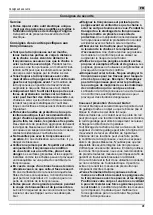
Operation
EN
34
Î
Ensure that the area of the cutting bar shown
in Figure
L
does not touch wood or other solid
objects. To minimise the risk of injury in the event
of a kickback, the device features a chain brake
which is automatically actuated by the kickback
and immediately stops the chain. For reasons of
safety always check that the chain brake func
-
tions before using the device. If kickbacks are
less violent, the chain brake may not be actuated
automatically. For this reason it is important that
the device is held firmly with both hands. The risk
of a kickback can only be reliably reduced by em
-
ploying a cautious and correct working method!
DANGER!
Risk of serious or even fatal injuries.
¾
Avoid any work for which you are not
adequately qualified!
¾
Extra caution is to be exercised at the
end of a cut, since there is elevated
risk of injury when the chainsaw swings
through.
¾
Reduce the risk of chainsaw kickbacks,
jumps and slips by:
• Considered, correct working – Hold the
chainsaw firmly with both hands and
with a firm grip.
• Watch the tip of the bar.
• Do not saw with the tip of the bar.
• Never saw multiple branches at once.
• Only introduce the saw chain to a cut
that has already been started with the
utmost caution.
• Note the position of the trunk and the
forces that can close the cutting gap
and jam the saw chain.
• Only saw using a correctly sharpened
and tensioned saw chain.
Sawing technique
Pull stroke sawing
M
With this technique the underside of the cutting bar
saws from top to bottom.
The saw chain pushes the device forwards away
from the user. The front edge of the device forms a
support which absorbs the forces which occur when
sawing on the tree trunk.
In pull stroke sawing the user has much more con
-
trol over the device and can better avoid kickbacks.
Therefore this sawing technique should be used
preferably.
Push stroke sawing
N
With this technique the upper side of the cutting bar
saws from bottom to top. The saw chain pushes the
device backwards towards the user. If the cutting
bar jams, the device may be thrown back towards
the user with great force.
Felling a tree
O P
WARNING!
Risk of injuries.
¾
Felling and limbing work may be per
-
formed by trained persons only!
Before starting felling work, ensure that:
-
There are no unauthorised persons and no ani
-
mals within the fall area
O
[A]
of the tree.
-
There is an obstacle-free escape route for all
those involved. Withdrawal
O
[B]
occurs at an
angle opposite the direction of fall.
-
The area around the trunk is free of obstacles
(risk of tripping!).
-
The next workplace is at least two and a half tree
lengths away. Before felling the tree, check the
direction in which the tree will fall and ensure that
there are neither objects nor persons or animals
within a distance of 2½ tree lengths.
A tree is felled in two stages
P
:
Î
Notch the trunk by approx. one third of its diam
-
eter on the side of the direction of fall
P 1
.
Î
On the opposite side make the felling cut
P 2
which must be slightly higher than the notch (ap
-
prox. 3–5 cm).
WARNING!
Risk of injuries.
¾
Never saw the tree trunk all the way
through.
¾
The area
P
[C]
is used as a "hinge" and
provides a defined direction of fall.
¾
When felling, stand only at the side of
the tree to be felled!
Trunks lying flat on the ground
Cut halfway into the trunk, then turn around and
saw through from the opposite side.
Attention!
When sawing through the trunk, ensure that the
cutting bar does not touch the ground!
Summary of Contents for CSH40
Page 1: ...MTD Products Aktiengesellschaft Saarbrücken Germany L 17 769 12533 ...
Page 2: ......
Page 3: ...1 2 mm ...
Page 4: ......
Page 5: ......
Page 6: ......
Page 218: ......
Page 219: ......
Page 220: ...MTD Products Aktiengesellschaft QGXVWULHVWUD H ෬ 6DDUEU FNHQ 7HO ෬ D ZZZ PGWSURGXFWV HX ...
















































